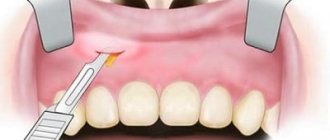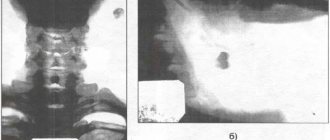Wisdom tooth extraction is a surgical procedure during which the third molar is removed from the dental socket.
This surgical intervention in uncomplicated cases is not particularly different from the removal of other teeth. The only thing that complicates it is the presence of a winding and long root system. The operation itself, with the exception of rare cases, is not a complex surgical procedure.
Wisdom teeth are considered rudiments, since they do not take part in the process of chewing food, due to changes in the diet of modern man.
They erupt at the age of 18 to 24 years. Previously, there were four of them in the jaw. Recently, cases have become increasingly common when molars are partially embedded or absent in the jaw altogether.
Cleaning them, due to their inaccessible location, is difficult. This contributes to the accumulation of plaque, which subsequently provokes the development of caries, damage to neighboring teeth, as well as various inflammatory processes in adjacent tissues.
Content:
- Peculiarities
- Indications
- Contraindications
- Operation
- Removal methods
- Difficult removal
- Stages
- Diagnostic value
- Does it hurt to remove
- Possible complications
Wisdom teeth or “eight” teeth, located at the edges of the jaw, erupt much later than their counterparts. Moreover, this often happens in adulthood, causing a person many unpleasant moments. The fact is that the structure of the human jaw does not provide enough free space to comfortably accommodate an additional pair of teeth. Therefore, “eights” often put pressure on “sevens”, they grow at an angle, their roots become curved, and it can be difficult to provide them with proper hygienic care, as a result of which caries develops. The peculiarities of the location do not allow for high-quality treatment of the wisdom tooth, and the optimal solution is its removal, since it bears neither a functional nor an aesthetic load.
Features of the structure of wisdom teeth
The structure of a wisdom tooth is no different from other molars and consists of a neck, a root system (4–5 pieces) and a crown. In some cases, root development is disrupted and a single conglomerate is formed, that is, a tooth grows with one root.
Its only difference from its neighbors is that recent studies recognize the wisdom tooth as a rudiment that has lost its functional purpose during the evolutionary development of man. Scientists do not consider it as a full-fledged organ, since some part of humanity does not grow it at all.
However, the wisdom tooth has several parameters that distinguish it from the same “seven”:
- lack of milk precursors, which ultimately complicates eruption and impedes growth. There is no room left for it on the dental arch, which is why various developmental pathologies arise;
- the number of roots is greater than that of other molars - up to 5 pieces. In this regard, problems often arise when removing a wisdom tooth;
- significantly curved roots of the “eights” make cleaning and treatment of root canals very difficult;
- poor blood supply compared to other teeth leads to rapid aging, accompanied by fragility and susceptibility of tissues to caries, despite minimal load;
- many pathological conditions, for example, pathologies of the masticatory muscles, malocclusion, pericoronitis, are associated with the growth of “eights”.
Thus, the appearance of third molars has many more negative consequences than positive ones. Many patients are forced to see a dentist even before they can be seen in person.
Healing time
The dentists of our clinic understand each patient very well. Any procedure associated with surgery is stressful for a person. And in the period after graduation, you will certainly want to have a snack, relieve stress with hot tea, smoke, and perhaps even drink something stronger. We ask: read the leaflet carefully and try to follow all the recommendations. As the tissues recover, the pain will disappear, and after 12-14 days the hole will be completely filled with epithelium. Take care of yourself, follow the doctors' recommendations and you will reduce the time spent on treatment!
Indications for wisdom tooth removal
Treating third molars is a challenging task, but a competent dentist will try to keep the unit relatively healthy. However, in practice, even relatively healthy “eights” are extremely rare.
Most often, problems begin at the teething stage, which is associated with pain, fever, swelling and other troubles. The doctor prescribes wisdom tooth removal if:
- an unerupted molar is incorrectly positioned in the jaw, injuring neighboring teeth and soft tissues;
- extensive caries damage with significant destruction of the crown;
- pericoronitis (presence of an inflamed hood);
- installation of a bracket system. Sometimes only the removal of a wisdom tooth can ensure the correct movement of other molars;
- presence of a cyst;
- the trigeminal nerve is pinched;
- pulpitis, periodontitis.
Most experts are inclined to believe that the “eight” should be under the supervision of a doctor from the moment of eruption. An x-ray is sufficient to assess the development of the tooth and assess future prospects. This needs to be done immediately, if only because for young people the rehabilitation period is much easier and the likelihood of complications is minimal.
Contraindications to wisdom tooth removal
Despite all of the above, there are situations when the mouth cannot do without the “eight” or the operation cannot be performed for other reasons:
- you need to install a bridge supported by the third molar;
- adjacent molars become loose, and a wisdom tooth is used as a base for applying a splint;
- due to the absence of chewing molars, the chewing function falls on it;
- period of pregnancy and breastfeeding;
- cardiovascular pathologies;
- impaired blood circulation;
- allergy to anesthetic;
- hypertensive crisis.
Simple wisdom tooth removal method
For a simple operation, the surgeon uses forceps and an elevator without resorting to incisions or drilling into the bone. This method allows you to extract a molar if:
- the upper wisdom tooth needs to be removed;
- there are no significant developmental deviations;
- there are no complicating circumstances.
Wisdom tooth removal proceeds as follows:
- 1. The dentist collects anamnesis, inquires about the patient’s allergic reactions to medications, and selects the optimal anesthesia;
- 2. an anesthetic drug is administered, its effect begins after about 5 minutes;
- 3. the surgeon prepares instruments, the sets of which differ depending on the location of the tooth, its condition, and the presence of inflammation;
- 4. Using forceps or using an elevator, the tooth is removed from the socket;
- 5. The doctor treats a fresh wound with antiseptic drugs;
- 6. If necessary, an anti-inflammatory agent is placed in the hole.
After the removal of wisdom teeth, large sockets remain, so the surgeon sutures the tissue to prevent infection and speed up healing. In the presence of purulent processes and inflammation, suturing the hole is not advisable, since the contents must have an unimpeded outflow. The manipulation usually takes no more than 10 minutes. To monitor the patient’s condition, the doctor schedules an examination a few days after the operation to remove the diseased wisdom tooth.
Complex wisdom tooth removal
During such an operation, the surgeon uses many more instruments and performs more complex manipulations, in particular, cutting soft tissues and suturing the incision without fail.
Complex removal is carried out if:
- we are talking about removing the lower wisdom tooth;
- there is an abnormal root system;
- the coronal part is severely destroyed;
- impacted, dystopic molars.
Preparation for the operation follows approximately the same pattern as for simple wisdom tooth removal, but this is where the similarities end. This is noticeable already at the initial stage: more time is allocated for the effects of anesthesia - about 10 minutes.
How to avoid paresthesia
To ensure that any tooth extraction occurs without complications,
you need to approach it wisely. Before surgery, the patient must undergo x-rays and an orthopantomogram. These methods will allow the doctor to study the structure of the root system of the tooth and draw up an effective plan for the upcoming treatment. An experienced dental surgeon should be responsible for removal.
It is necessary to understand that fear of possible complications is not a reason to postpone treatment until later. Trust your health to talented specialists, and then everything will be fine. Call our clinic and make an appointment.
Stages of complex wisdom tooth removal
The methodology may differ for each specific case, but in general terms several approximate stages can be outlined:
- 1. local anesthesia;
- 2. incision of soft tissues, peeling them off the bone;
- 3. sawing, drilling out the proper bone tissue;
- 4. extracting the “eight”;
- 5. treatment of a fresh hole left after the removal of a diseased wisdom tooth;
- 6. suturing with non-absorbable suture material;
- 7. The doctor will remove the stitches only after the edges of the wound have completely fused.
The duration of the procedure depends on the situation and can last from 30 minutes to 2 hours. After the operation, the doctor advises the patient regarding wound care, prescribes medications and informs the date of the next appointment.
How long does it take to heal?
In the first days after surgery, it is difficult to understand whether the gums are healing normally or with complications, because the blood clot has a whitish tint, similar to pus, and the gums can be very painful. To avoid mistakes, dentists recommend an examination 3 days after surgery. The doctor will evaluate the healing process of the wound and give recommendations for treatment.
Partial healing of the wound occurs 10-14 days after surgery, and complete recovery takes 20-30 days. Difficult figure eight removal may result in a longer recovery. Reasons for prolonged healing:
- severe injury to bone and gums;
- absence of a clot in the socket;
- inflammation of the socket;
- the presence of a foreign body in the wound, a bone fragment;
- the patient did not take antibiotics;
- old age of the patient;
- if the doctor did not stitch the wound.
The best way to speed up healing after major surgery is to place stitches in the gums. The suture will prevent infection, and the edges of the mucous membrane that are fastened together will quickly recover.
The patient is advised to follow these rules:
- the cotton or gauze swab is removed after 10 minutes;
- It is forbidden to eat for 3 hours after the operation, you can drink clean water;
- You cannot play sports for 2-3 days after surgery;
- Until the wound heals, it is forbidden to drink alcohol and smoke;
- It is forbidden to chew on the operated side.
If improvement does not occur 3-5 days after surgery, your health worsens and your gums hurt, it is recommended to consult a doctor.
The value of x-ray diagnostics when removing wisdom teeth
No qualified doctor will remove wisdom teeth “blindly”. You cannot rely on external indicators. A clear assessment of the condition of the root system and the development of the tooth is necessary in order to eliminate complications that could arise after the operation. An x-ray must be taken to assess the feasibility of removing a particular wisdom tooth.
X-ray examination provides an informative picture that allows you to see:
- the presence of curved roots;
- number of root shoots;
- structural features.
Based on the results of X-ray diagnostics, the doctor will be able to draw up a surgical plan and eliminate errors in the form of bone fragments remaining in the gum.
Contraindications
Removal of wisdom teeth has its contraindications. These include:
- acute infectious diseases, for example, pneumonia, tuberculosis, tonsillitis, etc.;
- strokes, heart attacks, ischemic attacks, hypertensive crises (if a similar condition was observed in the patient not so long ago, the removal of the wisdom tooth should be postponed until the condition normalizes);
- blood clotting disorder (the operation can be performed after certain preparation).
In most cases, wisdom teeth are not removed for pregnant women, since during this period the use of antibiotics and analgesics is limited (due to the risk to the fetus).
Is it painful to remove a wisdom tooth?
Many patients delay wisdom tooth removal due to fear of pain. Such fears in modern dentistry are absolutely groundless, since anesthetics are necessarily used for the procedure. Discomfort occurs when the effect of the drugs wears off and the analgesic effect decreases. But this is a physiological process that fades away on its own after some time. In addition, there is absolutely no need to endure pain; the doctor will prescribe medications to alleviate the postoperative condition.
When removing a wisdom tooth, some patients experience painful symptoms for a number of reasons:
- drug addiction;
- extensive purulent process;
- abuse of painkillers.
Also, the degree of pain depends on the method of removal, the condition of the wisdom tooth, and its location. For example, surgery on the upper jaw is easier. But removing a wisdom tooth from the lower jaw is more problematic due to the structural features of the jaw and large curved roots.
Signs of improper eruption of wisdom teeth in the upper jaw
Symptoms associated with improper eruption of figure eights:
- Soreness and swelling of the mucous membrane.
- Unpleasant odor from the mouth.
- Pain when opening the mouth.
- Enlarged regional lymph nodes in the parotid region.
- Cheek swelling.
- Pain spreading to the temple and infraorbital region.
Such signs may appear all together, or only a few of them. The intensity of pain depends on the individual characteristics of the structure of the jaw bone, nervous and vascular system of the patient. It is very important to determine the presence of inflammation, because there will be swelling, radiating pain and severe general condition.
Possible complications
Wisdom tooth removal is one of the most difficult operations in dentistry. Therefore, after it is carried out, various complications cannot be excluded. Thus, during the operation, neighboring “sevens” are sometimes damaged. Such severe consequences are the result of incorrectly chosen treatment tactics, as well as the low qualifications of the dentist, who was unable to understand the peculiarities of the patient’s anatomical structure.
Mature patients in some cases experience damage to the nervous system and, as a result, impaired sensitivity and numbness. Young patients encounter such disorders much less frequently.
A few hours after the removal of a wisdom tooth, bleeding may develop, which is most often provoked by intense rinsing, irritating the wound with the tongue, or eating hot food. This disorder is especially dangerous for patients suffering from hypertension and bleeding disorders.
Dry socket is the most common postoperative complication. Normally, after a wisdom tooth is removed, a blood clot forms in the socket, which promotes rapid healing of the wound. Sometimes a clot does not form, most often in smokers. After a few days, acute pain may appear, for which you should definitely consult a doctor.
Symptoms and signs
Symptoms that patients themselves complain about when problems with wisdom teeth occur:
- redness and swelling in the gum area;
- sharp or aching pain localized at the site of tooth eruption;
- the jaw opens poorly, the process is accompanied by nagging pain;
- feeling of discomfort when chewing food;
- bad breath;
- increased body temperature;
- painful swallowing.
If such symptoms occur, you must immediately consult a doctor who will conduct an examination, assess the situation and, if necessary, prescribe an x-ray.
Untimely treatment is fraught with aggravation of the situation, complicated by eruption or an inflammatory process in the area where the wisdom tooth is located. All this can lead to extensive abscess, phlegmon and osteomyelitis of the jaw.











